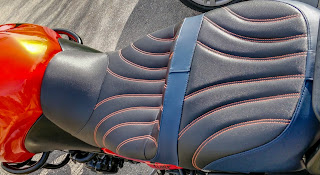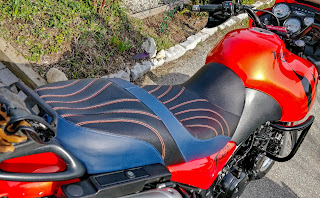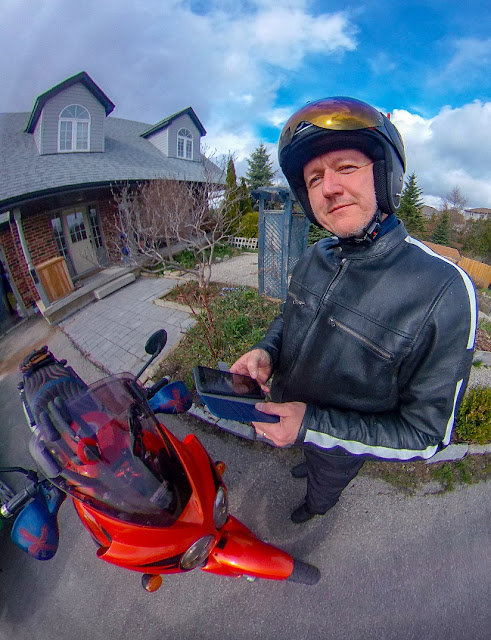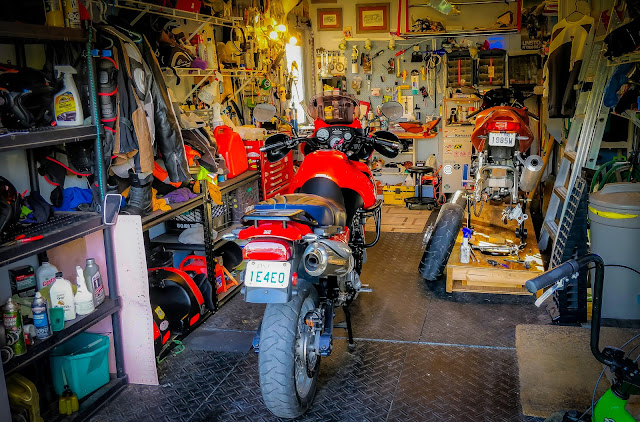from Blogger https://ift.tt/2uOLlRT
via IFTTT
The Corbin Experience
The big five-oh is coming up so I got myself a present. I’ve always wanted a custom saddle and after seeing buddy Jeff’s new Sargent seat, I started looking into what’s available for the Tiger. Sargent doesn’t do anything for Tigers as old as mine, but Corbin does. Their site lets you customize your seat with material and stitching. The Tiger isn’t a shy and retiring sort of motorbike, so I wasn’t very conservative in my seat design.
Corbin lets you play with variations on their online customizing tool. I started off with basic black but quickly moved on from there. You can go full disco oligarch if you want, but I looked at the Tiger and worked out a design that pulls the colours already on the bike together on the seat. I took the most shocking part of the Tiger, the Lucifer Orange paint, and did the stitching in orange. Most of the mechanical bits are black, so I stayed with a black set but went with a gripper material rather than leather. The side panels I matched in navy blue with the blue on the swing arm. The goal was to design a seat that looks like it belongs on the bike, and I think it does that while not being dull.
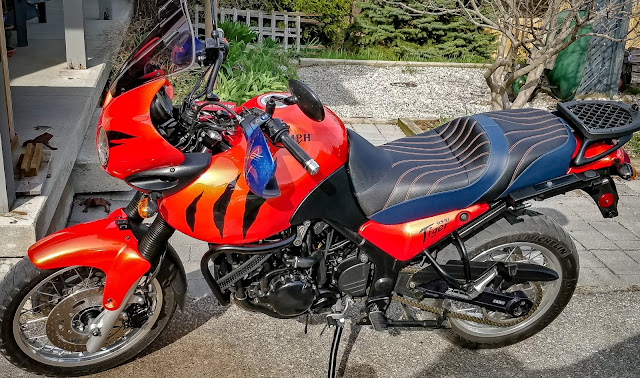 |
| It’s a pretty thing. |
The customization options offered by Corbin are exceptional. Less so was communication. I sent in the request online and got an email asking me to confirm the order. When I questioned the $120US delivery fee added on, I got no reply. The initial email also promised a follow up when the seat was going into production, but that didn’t happen either. What did happen was one day I got a bill for $94CAD on my front door when I got home from work. After driving over to the post office I got told there was a bill for taxes on the shipment, so that puts getting my Corbin to me at two hundred and fifty-five bucks (I could fly back from San Francisco where Corbin’s factory is for about the same price)… and I had to go pick it up.
The seat itself is very nice on top. The underside looks a bit rough with loose bits and rough holes , but I guess no one will ever see it but me. It’s heavy duty leather so it’ll take a while to break in and will look better and better as it does.
Comfort wise, it feels very different from the curved stock saddle. The Corbin is much wider, making the ground further away. I can flat foot the Tiger on the stock saddle even when it’s in its highest position. The Corbin doesn’t adjust for height, but its width makes it feel much taller. The width was such a concern that I tried standing on the pegs to see if the seat interfered with my legs. I can feel the seat (not so with the curved and narrower stock seat), but it’s not pushing my knees away, so I can still stand on the pegs if necessary.
The seat’s back is so steep that it feels like a small backrest, which does wonders for support and comfort. My son is too big now to pillion with me (we exceed the bike’s carrying capacity), but if my wife ever comes for a ride, I think she’ll have a better view from a higher back seat.
The seat feels firm, but Corbin mention that as it breaks in it will conform to your butt specifically and soften. The width of it handles weight so well that I really don’t notice the hardness, and it’s supposed to fade away over time anyway. They suggest a 2000 mile break in period, which seems like a long one, but it is what it is.
| It isn’t cheap, but the lifetime warranty takes care of any quality worries, and it seems a well put together thing, once I got it to attach to the bike. |
Installation wasn’t as easy as I’d have hoped. The Corbin is a single seat unit replacing a separate rider and passenger stock seat set. The stock rider seat has a couple of hoops on the frame that locate the front and a pin locking mechanism in the rear. The passenger seat has hooks on the front another pin locking mechanism at the back. The all-in-one Corbin seat doesn’t use the middle pin at all and wouldn’t locate and lock in the rear pin. Putting it on and off the big over and over trying to figure out why it wouldn’t lock ended up scratching the triangular side panels under the seat a bit, which was annoying.
I ended up removing the fuse box and taking out the middle locking pin as I was afraid it was preventing the seat from sitting down on the frame properly, but it ended up being the front metal bars that hook on the frame loops. They weren’t bent down enough to allow the seat to sit flat. After a bit of bending, I was finally able to get the seat to click into place.
I’m sitting higher on this new, firm Corbin seat, but it’s supposed to soften over time, so I think the height will ease a bit too. The ‘gripper’ fabric feels quality and tough and isn’t particularly grippy. I’m able to move around on it quite easily and I’m hoping it breathes a bit better than leather would. Hot seat in the summer is one of the things I’m hoping this solves.
I’d be happier with Corbin communicating (at all) and I’d have been a lot happier with the stratospheric shipping charge if it took care of border costs too. Paying the equivalent of airfare from San Francisco seems a bit excessive, especially when I get to deliver it to myself anyway. If you’re ever on holiday in northern California, pre-order your seat and then pick it up from the factory near San Jose and save yourself a pile of cash.
Overall? I’m happy with the seat. The upside is a quality seat that you can make uniquely yours for what I consider a reasonable amount of money for a bespoke item like this. When people are dropping twice this on slip on exhausts and helmets, the Corbin starts to look like good farkling value. It certainly makes a statement and as one of the key connection pieces between rider and motorbike, it’s a customization option that does a lot to make a bike feel special.
I just got back from a 232km romp across the Niagara Escarpment. Never once did I have to stop for numb bum. That’s never happened before, and it’s only supposed to get better?
Originally published from Blogger in May of 2019: http://bit.ly/2PP84mB
via IFTTT
Motorcyclist’s Bridge to Nowhere
I’m enjoying the new format of Motorcyclist magazine. It’s one of the few US bike magazines I make a point of getting. They write smart and with a Californian perspective that is very positive and engaging. Their new graphics format is like nothing else out there. They also take risks with their stories. In many other magazines you feel like you’re reading the same reviews and comparisons over and over again. Motorcyclist is like Bike UK and what Cycle Canada used to be in that you know you’re reading something unique. I think that has a lot to do with them focusing on getting the best writers rather than the most industry connected people they can find.
In the last issue they had a bit on towing a dirt bike into the desert using another motorcycle. It was a bit silly, kind of like a bridge to no where, but I could appreciate it from a more bikes is good perspective. Having said that, I have to question the logic of trying to go car-less this way. Towing a trailer means you’ve lost all the benefits of splitting lanes (try to imagine you’re somewhere sensible like California) and, you know, riding a motorcycle. They said at the end of the article that chucking the dirt bikes in the back of a truck instead of trailering them and towing them with two touring bikes would have been easier, but I think there is an even better way to make that all motorcycle ride into the desert.
| Things you don’t see anywhere else. It’s a story of excess, exhaustion and a lot of motorcycles. |
The KTM 690 Enduro weighs only a couple of dozen kilos more than the 250 dirt bikes used in the story. You get great wind on it while on the highway, unlike the hot and sweaty touring bikes used, and best of all the KTM costs about $27,000 Canadian less than a CRF-250X and a Goldwing. I bet it would take you across the sand and up the mountain they went to in the article as well.
It’ll take your camping gear and you don’t need to slavishly fulfill two motorcycle style requirements, so you can leave your ever so fashionable heavy leather touring gear behind.
If the point of the exercise is to get out there and back on two wheels, something like the KTM would have done the business, though it might have been a bit less dramatic doing it. The highways would have been full of wind blast and the nimbleness of two wheels rather than two towing two more. The off road riding would have been mighty close to what the 250 dirt bikes could do, and you’d be doing it all cheaper and more enjoyably.
Having said all that, what a great thing it is to see an article so uniquely silly and full of excess. I’m glad the editor let it happen.
The Swiss Army Knife KTM 690 Enduro.
http://ift.tt/2rJA4i0
http://ift.tt/2qqk8gB
http://ift.tt/2rJKdez
… and the new ones are in! http://ift.tt/2qq5oP5 If I had fifteen grand free I’d pop up to Ottawa and ride one back.
from Blogger http://ift.tt/2rskRSC
via IFTTT
Can You Run a Game Development Studio in a Senior Highschool Class?
Yes, you can!
 Over the past four years we have built a high school grade 11 and 12 software engineering program focused on video game design. The course uses the Software Engineering Body of Knowledge – a freely available document from the IEEE, that clarifies and develops the organizational and engineering best practices needed to build a modern video game. Using SWEBOK as a guide to project management and with the support of Unity, who gave us professional licenses for their game design software and Blender, a non-profit software company who offers professional grade 3d modelling software for free, we build our games.
Over the past four years we have built a high school grade 11 and 12 software engineering program focused on video game design. The course uses the Software Engineering Body of Knowledge – a freely available document from the IEEE, that clarifies and develops the organizational and engineering best practices needed to build a modern video game. Using SWEBOK as a guide to project management and with the support of Unity, who gave us professional licenses for their game design software and Blender, a non-profit software company who offers professional grade 3d modelling software for free, we build our games.
This semester our three student led groups conceptualized, planned and managed to completion three very different projects:
Slimecing: slime fencing game: Slimecing (@slimecing_) | Twitter
Nuclear Fist VR boxing simulator: Spook Box Games (@box_spook) | Twitter
Knockback Knights: physics driven FPS: Knockback Knights (@BackKnights) | Twitter
 Management is the most challenging part of the process. It’s hard enough to manage people to begin with, but when you’re a teen trying to manage other teens it becomes monumental. Setting high standards, encouraging collaboration, communication and goal setting to produce a transparent, adaptive and ultimately effective engineering processes is the real goal. Once again these students can’t believe what they’ve achieved in only 12 short weeks. Being an M level technology credit we have a full range of academic streams in the room, but the collaborative approach means everyone is working towards those higher standards.
Management is the most challenging part of the process. It’s hard enough to manage people to begin with, but when you’re a teen trying to manage other teens it becomes monumental. Setting high standards, encouraging collaboration, communication and goal setting to produce a transparent, adaptive and ultimately effective engineering processes is the real goal. Once again these students can’t believe what they’ve achieved in only 12 short weeks. Being an M level technology credit we have a full range of academic streams in the room, but the collaborative approach means everyone is working towards those higher standards.
This semester we worked cross curricularly with our arts department to build up our visual design consistency:
Concept Art Knockback Knights – Google Drive
Concept Art Slimecing – Google Drive
Concept Art Nuclear Fist – Google Drive
We’re thinking about working with business marketing students next year to expand our outreach. The cross curricular opportunities in this are continually expanding. Eventually we hope to have arts students helping us build a consistent and complex visual style, drama helping us creating realistic movement in our animations and business helping us market the results.
I just finished marking the exams. With a class average over 80% you’d think this is considered an easy course, but all the wishy washy types were shaken out in the first few weeks and replaced by keen students fighting to get into the course. Even those with exceptional final grades commented on how challenging and ‘real’ the course feels. One noted, “there is no where else where we’re trusted to work on a project this large and complicated.” It can’t happen if standards aren’t high, but the reputation of the course and the exceptional output it produces have done more to stream this course than academic streaming ever could.
 We’ve never run this course in semester one before. We’re over subscribed every year but not enough to spawn a second section. If we had multiple sections working on this we could hand off projects between semesters and run the course all year. We come incredibly close to making a viable game title in only eleven to twelve weeks in a single semester. If we can leverage the word of mouth from semester one, perhaps we can bump sign ups to about 50 students and warrant a second section. Were that to happen, both sections would still be 11/12 splits in order to encourage the handing on of hard won knowledge to new students.
We’ve never run this course in semester one before. We’re over subscribed every year but not enough to spawn a second section. If we had multiple sections working on this we could hand off projects between semesters and run the course all year. We come incredibly close to making a viable game title in only eleven to twelve weeks in a single semester. If we can leverage the word of mouth from semester one, perhaps we can bump sign ups to about 50 students and warrant a second section. Were that to happen, both sections would still be 11/12 splits in order to encourage the handing on of hard won knowledge to new students.***
You can download and play Slimecing from here: Slimecing by Q
…and here is their engineering review:
Slimecing Project Wrap Up Presentation – Google Slides
Knockback Knights and Nuclear Fist both intend to continue to develop their games but don’t have a release ready yet. Below are their engineering reviews.
Nuclear Fist Wrap Up Presentation – Google Slides
Knockback Knights Final Presentation – Google Slides
The Slimecing lead asked if we might start a GameDev club to continue working on these projects in semester two. That tells you something about how engaging our approach to tackling very complicated software engineering processes can be.
Two of our digital artists are taking a run at Skills Ontario’s 3d character modelling competition this year. We have grads from this course who have started their own game development studio with over a million downloads. We have graduates who have attended top programs at Waterloo University, Sheridan College and other post secondary locations who are now working in the industry. If you think it video games aren’t a big deal, you haven’t looked at the opportunities there lately.
Between this software course, one of the strongest grade 11 computer engineering classes ever, qualifying two teams for CyberTitan national semi-finals, and some very promising new grade 9s, what a satisfying semester it has been!
Follow these student software engineering projects on Twitter if you want to keep up with what happens next.
from Blogger http://bit.ly/2DDnPZB
via IFTTT
Motorcycle 360 Photography and Digital Art
Setting up a 360 camera on your wing mirror using a gorilla pod and setting it to automatically take a photo every few seconds seems like the best way to catch some interesting self portraits while you ride. It’s a set up and forget system so you can just enjoy the ride.
Afterwards you download what the camera caught and then frame the photos as you wish (the 360 picture lets you move the point of view around until you’ve framed something interesting).
I’ve been trying to replicate the tiny planet view that the Ricoh Theta could do in its software on the Samsung Gear360. GoPro makes a little planet capable app that they give away for free, so I’ve been using that. Here is an example of a time lapse video tiny-planeted in the GoPro software:
The photos are screen grabs of time lapse scenes on the Samsung 360gear. They’ve all been worked over in Photoshop to give them a more abstract look. I’ve included the original photo to show variations:
 |
| Here’s the original photo. |
 |
| Here is a posterized, simplified version. |
 |
| Here it is with an oil paint filter and a lot of post processing. |
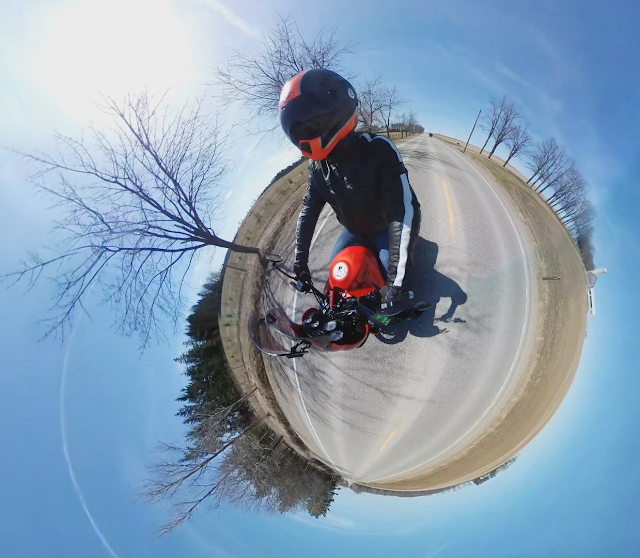 |
| Here is a tiny-world ‘wrapped’ image taken with the 360 degree camera. Below are some variations on it… |
Below are some other 360 grabs – they’ll give you an idea of how you can select certain angles and moments and then crop a photo out of them pretty easily.
One of the few things the Samsung does well is make time lapse video fairly straightforward (I miss my Ricoh Theta). The software Samsung bundles with the gear360 only works with Samsung phones (which I don’t have). The desktop software won’t render 4k video at all (it ends up so blocked and pixelated from artifacts as to be almost useless). And when you’re first importing video it takes ages for the software to open a video for the first time. By comparison the Ricoh renders video almost instantly, has never had artifact problems when it renders and has never crashed on me (the Samsung software has crashed multiple times). If you’re patient and are ok with crappy results, go for the Samsung. Meanwhile, here’s what I could get out of the damned thing:
This is a 360 fly video sped up, the weekend after the April ice storm:
Software used: Adobe Photoshop CC, Adobe Lightroom CC, Paper Artist, Windows movie maker, Go-Pro VR Viewing software
from Blogger https://ift.tt/2jeSRfi
via IFTTT
Dark Arts: Motorcycle Digital Art from the Depths of Winter
January 13th, 2019. High of -21°C, low of -29. I’m months away from riding with months to go until I do again. This is as close as I can get to the saddle, some motorcycle digital art…
from Blogger http://bit.ly/2Hb0CSm
via IFTTT
One Tight, Not Too Tight
Now that the CBR900RR Fireblade project is sorted and on the road, I’m finding myself doing what the original intent was in getting it: learning from a different type of motorcycle. Unlike the heavy industry Kawasaki Concours, or the SUV of motorcycling Triumph Tiger, the ‘Blade was built to a different design brief. The other bikes were over engineered heavy to last, but the the Honda is a feather.
That philosophy is at odds with the heavy handed git who owned it before me and managed to maintain it into such a state of disrepair that it kept it off the road for years.
From the rear brake cylinder that was assembled backwards and over tightened, to the over tight wheels and the slipping clutch I’ve just adjusted to actually be at spec rather than over-tightened, I’m finding the Honda was a victim of a heavy hand and unsympathetic mechanical inclination.
When I was a teen my dad was talking me through a head gasket repair on one of my first cars. We weren’t minted, so the only way I was driving was if I could keep an old car on the road; mechanical training was an implicit part of vehicle ownership for me growing up. As we were tightening the head back on he made a point of talking me through the bolt pattern – always tightening opposite bolts so it would seat evenly, and then said something that I’ve never forgotten as we started tightening down the head: “always one tight, not too tight.” I guess the guy who abused this lovely piece of Honda engineering into years in a garage never got such good advice.
Mechanical sympathy is an important part of maintaining any machine, but especially a motorcycle, where if you are cack-handed you can end up seriously hurting yourself when it breaks. In that way, motorcycle mechanics are a lot like aircraft mechanics, it’s a do it right or it can go very wrong kind of situation.
Part of that sympathy is taking the time to understand what the engineers who designed the machine want you to do in terms of looking after it. In the case of the CBR900RR, Honda would like you to leave 10-20mm of play at the end of the clutch lever – this one was set so you could strum it like a guitar string. This play is to ensure that the clutch fully disengages when you let go of it. An over tightened clutch cable means it’s always set to be slightly pulling and engaging the clutch. Making it too tight isn’t just a failure of the hands, it’s a failure in thinking that wounds the machine. In this case, the over-tightened clutch cable explains why the ‘Blade was slipping RPMs when I opened it up. A sympathetically tuned motorbike will give you a purity of interaction that allows you to more fully understand the machine. This is one of the reasons why I value technical fluency so much, it puts your ability to operate technology into focus in a way that the technically ignorant will never realize.
***
 Meanwhile, in the land of Tim where he’s trying to keep a 17 year old European and a 23 year old Japanese bike rolling during the perilously short Canadian riding season, the Tiger’s stalling when hot continues. I’ve ordered a replacement air idle control valve from Inglis Cycles, who have once again exceeded expectations during a pandemic by sourcing the part from Triumph in the UK and getting it to me in about a week.
Meanwhile, in the land of Tim where he’s trying to keep a 17 year old European and a 23 year old Japanese bike rolling during the perilously short Canadian riding season, the Tiger’s stalling when hot continues. I’ve ordered a replacement air idle control valve from Inglis Cycles, who have once again exceeded expectations during a pandemic by sourcing the part from Triumph in the UK and getting it to me in about a week.
One of the nice things about the Tiger is that it’s fuel injected, so all that carburetor management is taken care of, but the evil end of computerized fuel injection is that after seventy six thousand kilometres it’s finally gone wrong, and an electronic system like that can go wrong in a lot of different ways.
I’d never gotten into the Tuneboy Software that came with the Tiger (the original owner installed it along with a Power Commander), because if it ain’t broke, don’t fix it. But now that it’s broke, I got going on it the other evening. Getting into the bike via a computer was pretty cool. The software is Y2K retro-hip and the connection was straightforward. The 20+ pages of instructions weren’t really needed (I’m handy with computers). Windows 10 automatically recognizes what you’re plugging in (back in the day, WinXP would have needed drivers installed), and the software is responsive and quick to connect. It occasionally drops connection, but unplugging it and plugging it in again resolved that each time.
The compact disk (told ya, Y2K hip!) had all of the stock maps for my year of Triumph Tiger 955i engine on it, so I saved what was on there in case it was some kind of cool specialty map the previous owner had worked out (dude worked at a nuclear power plant, so don’t underestimate his tech skillz), and then I flashed it with the stock numbers, which took about 20 seconds and returned a confirmed result. There is a slight lag, but otherwise this is easy to use stuff.
 I then played with the diagnostics tool for a bit, hoping for some data that will help me isolate the hot idle stalling fault. The software says there are no errors (promising that this is that mechanical failure then), and the only thing that looks out of place is a strange return on the engine temperature. It seems to read accurately and then show -40, even when the fan is coming on, but if the fan is coming on and the temperature gauge on the dash is reading normally, I suspect this is something to do with how the software syncs with the on board computer rather than an actual fault, but I’m going to keep it in mind.
I then played with the diagnostics tool for a bit, hoping for some data that will help me isolate the hot idle stalling fault. The software says there are no errors (promising that this is that mechanical failure then), and the only thing that looks out of place is a strange return on the engine temperature. It seems to read accurately and then show -40, even when the fan is coming on, but if the fan is coming on and the temperature gauge on the dash is reading normally, I suspect this is something to do with how the software syncs with the on board computer rather than an actual fault, but I’m going to keep it in mind.
The problem with an idle fault on a fuel injected bike is that the engine management system is taking in data from a number of sensors and using it to balance engine activity, like idling, based on that information. I’ve got the mechanical component that regulates idle on the bike incoming, and I hope that resolves the issue, but what I fear is that it’s something else, and with these complex electronics systems could mean that anything from a dozen different sensors or relays to a loose or broken wire. With any luck, it’s that idle air control valve and I’m back on the Tiger… and the Honda, just not at the same time.
from Blogger https://ift.tt/2Y0mZjG
via IFTTT
Motorcycle Destinations: Mostly Ironheads In Elora, ON.
There was a time when every motorcyclist was also an amateur mechanic. Getting your hands dirty was the only way to keep early motorcycles running. We’re over a century into the evolution of the motorized bike now and, as in all places, digitization has taken over. Modern mechanics are now called technicians and have to be as adept at communicating with the computers on a modern motorcycle as the old school types were at diagnosing a mechanical fault with their senses. Both are complicated, but in quite different ways. There are obvious advantages to modern bikes in terms of efficiency, ease of use and dependability, but motorcycling is inherently a compromise in convenience, and many of the iconoclasts who escape the clutches of automotive transport to ride in the wind question the replacement of human skill with automated assistance.
Back in the day the motorcyclist themselves performed many of the tasks that a modern day technician does, so what was left to the old school mechanic? What you’d typically find in a pre-war motorcycle repair shop looked more akin to a machinist’s bench than the antiseptic, electronically focused diagnostics bay of a modern day garage. That ability to manufacturer your own parts and diagnose problems without computer support, using only your senses and your hands might seem simplistic and archaic, but it was nothing of the sort. There is a secret art to working with pre-electronic, analogue motorcycles that trips up many modern technicians who, while adept in leveraging digital tools to diagnose digital machines and replace parts, struggle to diagnose and repair mechanical faults.
***
 If you’re into restoring older machinery, this vanishing skill set is hard to come by, but I’m fortunate to live near one of these rare, independent, locally owned shops. Lloyd Gadd is the owner and operator of Mostly Ironheads in Elora, Ontario. With decades of experience in mechanics, he approaches motorcycle repair old school. His shop is part machinists, part mechanics and part historical ode to The Motor Company. Lloyd focuses on older Harley Davidsons, but as the name of the shop implies, it’s not an exclusive focus. Lloyd is also a qualified mechanic who can do everything from MoT safeties to changing a tire.
If you’re into restoring older machinery, this vanishing skill set is hard to come by, but I’m fortunate to live near one of these rare, independent, locally owned shops. Lloyd Gadd is the owner and operator of Mostly Ironheads in Elora, Ontario. With decades of experience in mechanics, he approaches motorcycle repair old school. His shop is part machinists, part mechanics and part historical ode to The Motor Company. Lloyd focuses on older Harley Davidsons, but as the name of the shop implies, it’s not an exclusive focus. Lloyd is also a qualified mechanic who can do everything from MoT safeties to changing a tire.
I was in there most recently getting last winter’s Fireblade project safetied, and in the process Lloyd’s prompt service got me looking at a better way to do motorcycle tires that will save me a significant amount of money. While I was over there I also did a round of photography to give you a sense of what goes on in this old school shop.
 |
| Multiple engine rebuilds of air cooled Harley twins were ongoing in this small but dense workspace. |
 |
| Unlike like most modern shops that simply refuse to work on long term mechanical or machinist driven repairs in favour of high turnover/quick to repair parts replacement, Mostly Ironheads will actually machine parts and rebuild a motor from the ground up. |
 |
| It’s a whole other level of mechanical commitment when you are prepared to turn your own parts out. |

Lloyd has a number of customer projects on the go, and also makes a point of collecting older and vintage parts. If you’re fan of Harley Davidson you should make a point of riding up to Elora and checking out what’s on hand – in many cases you’ll see parts that are so rare that you may never have seen them before, even if you’re into classic hogs.
Lloyd told me the story of a 1950s Harley racing motor he’d come across. Only one of the two heads is accurate, but he’s on the lookout for a replacement – though seven decades old serviceable racing parts don’t survive well, as you can imagine. When he has this rare piece of motorcycling history back together it’ll be one of the few remaining complete Panhead racing motors in existence. You might think that’s a one off, but not in this shop. Even if you’re not into HD, this place is an ode to moto-mechanical history and worth a stop. Air cooled bikes have an aeronautical aesthetic to them that modern bikes often miss.
 |
| The machining needed to sort this head out is impressive. It had worn down below spec so is now being built back up and reground to specifications. When you can machine your own parts, you’re as much an engineer as you are a mechanic. |

Being a restorer, Lloyd is always on the lookout for parts, and the shop is an ongoing work in progress, with parts coming in and getting sorted and stored until needed. Previous customers, online and estate sales and various other connections like the Harley Owners Group mean Mostly Ironheads are able to draw in older parts, often found in boxes of ‘stuff’ that get dropped off.
Lloyd mentioned a customer who dropped off a box of stuff while clearing out space at home. In the process of going through it they discovered an unopened complete carburetor assembly still in the original factory packaging from the mid-sixties! There is a joy in bringing a piece of history like this back to life, and the joy is alive and well at Mostly Ironheads. If you’re in Southern Ontario, it’s an easy ride up north of Guelph to the shop.
 |
| This is that racing motor – one of the heads is incorrect, but the rest is intact and very rare! |
These are the cam lobes for that racing head compared to a typical one. Not only is the racing cam lobe lighter with hollowed shaft, but it’s also heavier duty in terms of strength. Here and here are good primers on cam profiles if you’re curious. Whereas the right side regular cam is designed for long term use and efficiency, the more radical racing came on the left is designed to stay open longer, rev high and produce more power, though it wouldn’t idle well, get good mileage or run smoothly. But when you’re aiming for all out speed, you’ll put up with that just so you can wind it up and go. You’re unlikely to see mechanical history like this anywhere else in Ontario.
 In addition to the restoration work going on, you’ll also find an eclectic mix of older, finished air cooled Harleys ranging from customized choppers to more standard rides. If you’re into older, air cooled machinery, this will really float your boat.
In addition to the restoration work going on, you’ll also find an eclectic mix of older, finished air cooled Harleys ranging from customized choppers to more standard rides. If you’re into older, air cooled machinery, this will really float your boat.Lloyd’s area of interest extends from post war bikes all the way up to the last of the air cooled, carburettor fed bikes. If you’re into graphic design, you’ll see everything from post war art deco to sixties and seventies disco and eighties futurism in the logos and bike designs.
There are some core elements to Harleys (like v-twin engines), that evolve slowly, but design wise they’re much more in tune with their times than you might have assumed.

from Blogger https://ift.tt/3d4XQbQ
via IFTTT
Macro Lens! Finally!
Just got the Canon macro lens for the Rebel T6i. You can get lost in an icicle with this thing!
…eyeballs!:
… and some morning glory:
from Blogger https://ift.tt/2zSjyyZ
via IFTTT
Would You Stop?
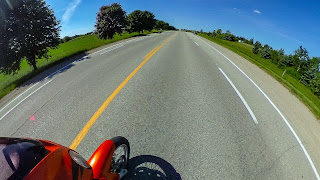 The other week I was out for a short ride up and down the river on a swelteringly hot day. On my way back home I was accelerating out of the small hamlet of Inverhaugh when I noticed a bike down on the side of the road and the rider standing there looking at it.
The other week I was out for a short ride up and down the river on a swelteringly hot day. On my way back home I was accelerating out of the small hamlet of Inverhaugh when I noticed a bike down on the side of the road and the rider standing there looking at it.
I immediately checked my six (empty road) and indicated to pull over. I stopped about 50 feet up the road from the downed rider and walked back.
 |
| Rider down, would you stop? The four guys in front of me on Harleys didn’t – though the nice couple in the Ford did… |
The rider turned out to be Natalie, a 20-something on her first bike, a Ninja 300. She couldn’t lift the bike, which had fallen when she stopped to check directions, so I helped her get it back on its feet. All was good except a bent shift leaver which was pushed in to the point where it was interfering with the frame – we couldn’t get the bike in gear which means she couldn’t ride home.
If I’m going any distance I have a tool kit on the bike, but this being a short ride, I wasn’t so equipped. Natalie had been out all day in the sweltering heat and had elected to head home rather than stop with the group she was with for a late lunch. Exhaustion (no doubt some of it heat related) and a moment of broken concentration conspired against her and the bike tipped over.
A car with a couple in it has stopped so I asked if they had a tire iron I could use to gently bend the shift lever out. I didn’t want to yank on it too hard for fear of damaging the seals. There was fresh oil around the lever, so I was worried that it had already been damaged in the fall. The couple didn’t have a tire iron – but I suspect it was more a case of they didn’t know what that was or where to find it. With no one else stopping in spite of frequent traffic and our options limited, Natalie called one of the riders she’d been with who was only 10 minutes away, back in Elora at a restaurant.
A few minutes later, under the sweltering sun, a Suzuki Hayabusa showed up with a “fuck fear” sticker on the windshield. The hard man riding it hopped off and went about yanking on the gear lever until it was clear enough to move freely – he seemed determined to resolve things quickly. I told Natalie and her friend that if they needed any assistance I was only 10 minutes away in Elora and they would be welcome to come by if they needed tools, and then I left.
As I pulled away all I could hear were stereotypes ringing in my ears. I’d initially seen a sports bike down and a rider in sporting gear on the side of the road and had to fight an involuntary prejudice that they’d been assing around and tossed themselves at the countryside. That, of course, wasn’t what had happened at all – it was a case of a fairly new rider doing too many miles in tough conditions and underestimating how physically demanding that can be. We all do that to start off with – I told Natalie how I’d dropped my first bike several times while trying to do too many things at once.
Then there was the moment as I approached when I thought, hmm, that’s a mighty small fellow, before I realized I was approaching a female rider who was looking frustrated and overwhelmed. My wife later asked if I was worried about stopping and making her uncomfortable. That hadn’t occurred to me at all, but perhaps it should have. Considering the circumstances, I think safety trumps any worries about chivalry or chauvinism.
When the ‘fuck fear’ ‘Busa showed up with rider to match, I was again fighting that sense of stereotyping, but he had cut out on everyone else and a much needed late lunch to get out there and help his friend. All the tattoos and attitude couldn’t hide that sense of kindness.
Then there were the ten or so cruisers that puttered by without stopping or even slowing down to see if everyone was alright. These are the hard core types in leather who go on and on about how nice bikers actually are and how they always stop to help a fellow rider. Perhaps these brotherly and sisterly biker types were all late for some kind of pirate fancy dress party; there was another stereotype broken – or perhaps they only help their own subculture.
Any time I see a rider on the side of the road I slow and give them a tentative thumbs up, which they have so far always returned. If they didn’t, I’d stop to see if I could help. This doesn’t have anything to do with a magical bikers code of conduct or chest thumping self-righteousness. If someone on a motorcycle (any motorcycle, it doesn’t have to be made in Milwaukee) is stuck on the side of the road, they can’t sit in a safety cage and they’re at the mercy of the elements. Leaving them out there because you’re too selfish or lazy to stop is both dangerous and cowardly; riding by like you didn’t see it makes you a giant tool, even if you do like to strut around telling everyone what a paragon of virtue you are.
I’ve no regrets about stopping. I’ll keep doing it because it’s what everyone should do.
from Blogger https://ift.tt/2S1hVXQ
via IFTTT







